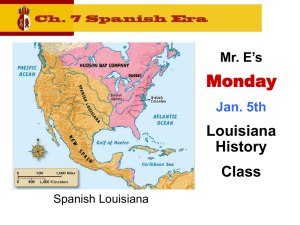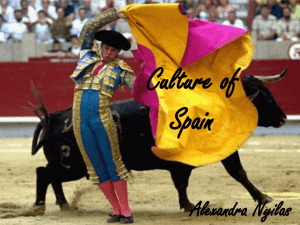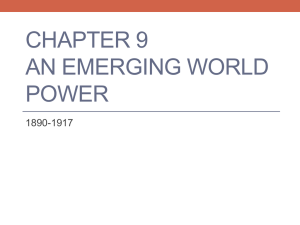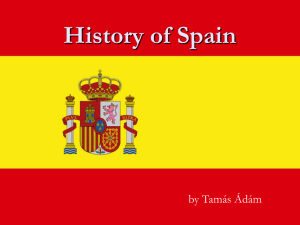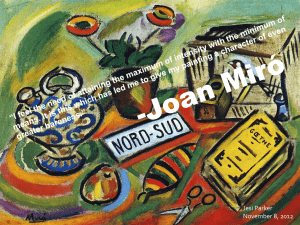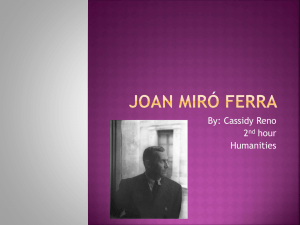Louisiana: Our History, Our Home
advertisement
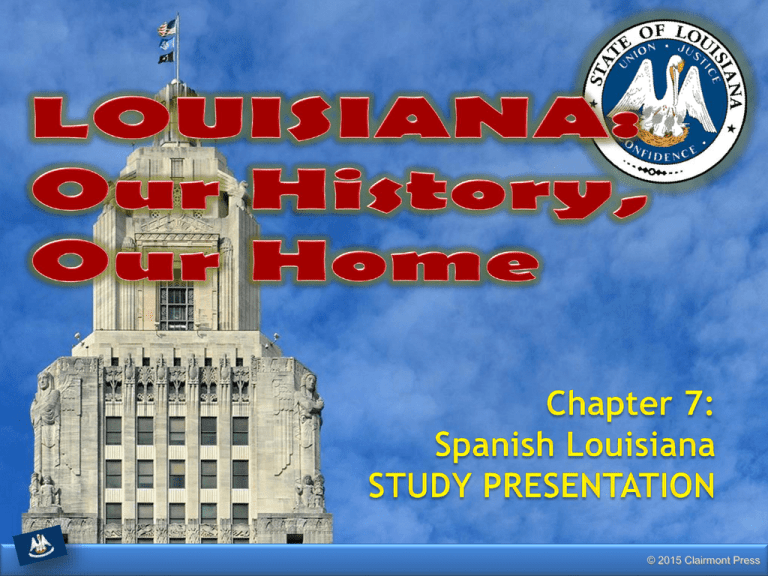
© 2015 Clairmont Press Section 1: The French and Indian War Section 2: The Transition to Spanish Control Section 3: The American Revolution and the Last Decades of Spanish Rule Section 4: Spanish-Era People and Immigrants 2 Section 1: The French and Indian War Essential Question: • What were the causes and effects of the French and Indian War? 3 Section 1: The French and Indian War What terms do I need to know? • French and Indian War • Treaty of Fontainebleau • Treaty of Paris of 1763 4 Introduction European countries were always competing for lands when colonizing America. The French and British were both trying to take part in the fur trade. The rivalry between France and Britain resulted in open warfare. 5 European Claims in North America before the French and Indian War 6 The Outbreak of War War was declared between Britain and France in 1756 and did not end until 1763. The British called it the French and Indian War, while the French called it the Seven Years’ War. During the war, five European countries were pulled into the fight. Spain joined the side of the French to protect Mexico. 7 A Secret Transfer At the end of the war, the French secretly gave Louisiana to Spain in order to keep it from Britain. This agreement was called the Treaty of Fontainebleau. Spain was willing to take Louisiana in order to protect their silver mines in Mexico. 8 Treaty of Paris of 1763 The war ended at the Treaty of Paris of 1763. In the end, France lost all of the land it controlled in North America aside from some islands in the Caribbean. Spain traded Florida to Britain for the return of Cuba. The British were irritated because of the growing importance of the Mississippi and their inability to gain Louisiana and the port of New Orleans. 9 Section 2: Transition to Spanish Control Essential Question: • How did the colonists in Louisiana react to Spanish rule? 10 Section 2: Transition to Spanish Control What terms do I need to know? • • • • militia Cabildo Code O’Reilly laissez faire 11 Introduction The North American continent was divided between Spain and England after the war. Spain had many colonies and wished to keep Louisiana a small investment. Spain attempted to make Louisiana’s transition into their government smooth. Many colonists were not interested in cooperating with the Spanish, and some even appealed to France for help. 12 European Claims in North America after the French and Indian War 13 The Colonists Revolt Fear and desire to protect their economy caused the residents to revolt in 1768. A petition signed by the rioters was given to the Superior Council, asking to kick out Spanish Governor Ulloa. He was removed from the colony, returned to Spanish territory, and made many reports on the revolt. 14 Spain Takes Effective Control When Spain returned, they corrected many mistakes made in Ulloa’s time as governor. They appointed General Alejandro O’Reilly to lead their military back into the colony. O’Reilly spent much of his time in the colony finding the leaders of the revolt. After dealing with the leaders, he earned the nickname “Bloody O’Reilly”. 15 Spain Takes Effective Control (Continued) Despite his nickname, O’Reilly was a fair and effective administrator. Through his work, improvements in regular trading practices, militia organization, and Native American relations occurred. A militia is a military force composed mainly of citizen-soldiers. O’Reilly reorganized the government by replacing the French Superior council with a Spanish Cabildo, or governing body. A set of laws based on older Spanish laws was adopted and called the Code O’Reilly. 16 Governor Unzaga After O’Reilly stepped down as governor in 1770, a man named Luis de Unzaga was given the job. He quickly gained some advantages by marrying into a wealthy family. He was more practical about the economy in New Orleans, overlooking illegal business with British traders and such. 17 Bernardo de Gálvez: Governor and Hero After Unzaga’s eyesight failed, he was replaced by the younger Gálvez in 1777. He, like Unzaga, also benefited from a marriage into a wealthy family. Unlike Unzaga and his policy of laissez-faire (noninterference by the government in economic matters ), Gálvez worked to to keep out British trade. Gálvez also supported economic endeavors and managed to get the Spanish to give more money to run the colony. 18 Section 3: The American Revolution and the Last Decades of Spanish Rule Essential Question: • How did the final years of Spanish rule and the American Revolution impact the people of Louisiana? 19 Section 3: The American Revolution and the Last Decades of Spanish Rule What terms do I need to know? • • • • American Revolution Treaty of Paris of 1783 Articles of Confederation gens de couleur libres 20 Introduction The French and Indian War took a huge economic toll on all countries involved, especially Britain. To get money back, the British decided to tax goods used by American colonists. The colonists were upset by these taxes along with “taxation without representation”. With tensions rising, the American Revolution (the war in which the American colonists fought for their independence from Great Britain) was inevitable. After seven years of long and bloody struggles, a compromise was reached known as the Treaty of Paris of 1783. 21 The Colonies Unite Before the war had even ended, the colonists had agreed to the Articles of Confederation. However, they meet in 1787 to rework the articles, eventually creating the United States Constitution. It would be 23 years before Louisiana joined the United States and was subject to the constitution. 22 Spain in the American Revolution The Spanish entered the fight slowly but gave great advantages to the colonists secretly. Eventually, the two had a more open partnership after the Spanish also declared war. Over the next two years, Governor Gálvez led many attacks against British outposts and forts in Florida, resulting in complete victory in Florida. 23 Governor Miró Esteban Miró gained much experience in governing Louisiana while Gálvez was away fighting in Florida. He became the real governor after Gálvez retired in 1785, by which time New Orleans was a thriving, but disorderly city. 24 New Regulations Miró tried to better regulate New Orleans since it had developed a reputation for pleasure seeking and rowdiness. In 1786, Miró announced a new set of rules called Miró’s Bando de Buen Gobierno (Miró’s Proclamation for Good Government). Miró tried to better monitor taverns, gambling establishments, and tried to discourage trade on Sundays. Many people disliked the new regulations, and some ignored them. 25 More Tolerant Slave Laws In slave laws, Miró implemented Spanish laws, which respected slave owner rights as well as slave rights. He instituted the practice of slaves buying their freedom, creating a large population of gens de couleur libres, or free people of color. Outside New Orleans, however, many Frenchdescendent planters ignored Spanish law and continued to use the French Code Noir, which gave masters almost complete legal authority over their slaves. 26 A Devastating Fire Miró gained much popularity after helping in the aftermath of a devastating, city-wide fire in 1788. The fire was caused by a resident lighting candles in his home chapel and resulted in the destruction of almost 80% of the buildings in New Orleans. Miró helped citizens who has lost everything and helped rebuild the city. 27 Encouraging Anglo Migration Miró also encouraged immigration of British or British-descended colonists, also known as Anglos. These colonists were different from those native to Louisiana because they spoke English and practiced religions other than Catholicism. The Anglos settled in Louisiana’s northern and western frontiers, as a result of land grants offered by the Spanish government. 28 Governor Carondelet Governor Carondelet became governor after Miró returned to Spain in 1791. He is credited for creating an oil-lit lamp system that provided light for the city at night. He also monitored the construction of a major canal that connected the heart of the city with Bayou St. John. 29 Revolutions in France and SaintDomingue Carondelet oversaw Louisiana during a time of great unrest that included the French Revolution and slave uprisings. When the French Revolution began in 1789, unrest amongst the colonists in Louisiana also began, but Carondelet closely monitored the colony for signs of revolution. After the slave revolt in Saint-Domingue in 1791, thousands of people fled the island for Louisiana. 30 A Slave Conspiracy In 1795, rumors of a slave conspiracy in Pointe Coupee Parish reached New Orleans, where officials were told of a planned slave revolt. Carondelet led an investigation that resulted in 60 convictions. Of those convicted, 23 slave conspirators were executed. 31 Final Spanish Governors The last two Spanish governors, Manuel Gayoso de Lemos and Manuel Juan de Salcedo, served very short terms compared to the others. While not in office long, each of these governors’ time in office, along with people moving into the state, brought about many changes in Louisiana. Some challenges seen in these years would lead to great changes in the administration of Louisiana. 32 Section 4: Spanish-Era People and Immigrants Essential Question: • How did the groups that immigrated to Louisiana during Spanish rule influence the culture of Louisiana? 33 Section 4: Spanish-Era People and Immigrants What terms do I need to know? • refuge • subsidize • Malaguenos 34 Introduction The ability to attract settlers to Louisiana was one of the great successes of the Spanish colonial era. The Spanish would help establish settlements and find jobs to ensure the new settlers stayed. Many of the groups that moved to Louisiana maintain their old ways to this day. 35 Acadians These were French migrants who had been in New France, or Canada, since the 1600s. After the British took Canada and removed them from their homeland, the French offered refuge, or protection from danger, in Louisiana for them. Wanting more settlers, the Spanish continued this policy. Acadians made a distinctive impression on the economy, culture, and southwest territory, known today as Acadiana. 36 Isleños & Malaguenos During the American Revolution, the Spanish wanted immigrants that could be soldiers as well. They subsidized, or paid for, the transport of many people from the Spanish-owned Canary Islands in the Atlantic Ocean to help build a militia. After the war and much moving around, most finally settled in what is now St. Bernard Parish. The Malaguenos, from the Málaga region of Spain, were supposed to be farmers, although most found success as cattle herders and ranchers. 37 Anglos After the American Revolution, many Anglo settlers wanted land, and Spain had plenty to give. The Spanish hoped the arrival of the Anglos would discourage the migration of Englishspeakers to the areas that bordered their silver mines in Mexico. These hopes were dashed as many Anglos migrated to Texas. It was their influence that ended up causing one of the biggest real estate transfers in history. 38 Image Credits Slide 1: Chris Miceli on Wikimedia Commons, Public Domain; Slide 2: Ken Thomas (alligator); Jillian.E (Chicot State Park); City of Monroe, LA; Albert Herring (Mardi Gras), Lael Butler (pelican); Jesper Rautell Balle (cajun meal); Susan Adams (Chemin-a-Haut State Park) on Wikimedia Commons; Image Credits Slide: Edd Prince on Wikimedia Commons; maps copyright Clairmont Press; all others public domain Shown here: Fontainebleau State Park Return to Main Menu 39
